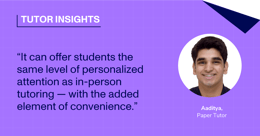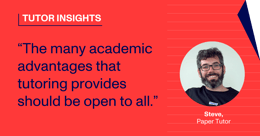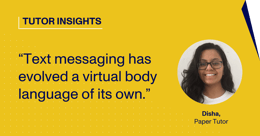
7 Steps to Take for Breakthroughs in Student Learning
This post is part of a series written by Paper's tutors. Each post takes you behind the screen, uncovering their perspectives and expertise. This week, Tutor Laura describes how to change your approach when a student continues to struggle.
Tutoring online for Paper has been a learning curve for me as a student and as a teacher in training.
When I tutor on Paper, I have the unique perspective of being both the learner and the lecturer simultaneously.
Every day I get to contemplate what is and isn’t working for me as a student and question how the instructor could have done things differently based on that: Maybe they reached the audio learners in the room or the visual learners, but forgot all about the kinetic learners. Regardless, I have learned that both individuals (the teacher and the student) are in a position of growth.
One of the biggest lessons I am continuing to learn about is how to help a student when they continue to struggle with a particular concept.
When a student faces this block, that is, a certain concept that simply won’t unwind in their brain into a clear, logical thought, it can be frustrating for them. Why doesn’t this make sense? Why can’t I get past this step?
As a tutor, it can be difficult to break down one concept in a plethora of ways. We may have learned about it in one particular way and thus tend to try and teach it in that same manner.
The challenge comes when we have to expand our own thinking on a topic in order to reach a student who learns differently than we do; when a student is continuing to struggle with a concept.
We as tutors have to stop and pull apart that topic all the way down to its roots.
This concept-dissection requires a few steps:
1. What previous knowledge is required for one to understand this topic?
2. Have we checked that the student has this knowledge?
3. If yes, move to the next step.
If no, take time to backtrack and build some of this necessary understanding.
4. What ways have you tried explaining this concept so far?
Have these explanations suited a particular type of learner?
5. If so, try looking at the concept through a different lens.
This will vary based on the subject. However, it is important to try using different words to phrase a question or different steps and scaffolding to take the student from A to B.
6. When in doubt, try comparing it to a similar concept in another subject or to a modern-day example.
That might be more accessible to the student.
7. One of the best elements of Paper is that you have access to your fellow tutors who are working at the same time as you.
Not to mention an awesome management team. As a last resort, reach out to other tutors and ask if they have any ideas that you haven’t tried yet. Sometimes we just need to see the concept through fresh eyes in order to make a break through with a student.
Thus, online tutoring can be an adventurous guessing game, a team effort and a sullen commitment to keep on trying.
We are constantly learning from our students as they learn from us, and this reciprocal relationship is both a joy and a challenge. We are pushed to find new ways to look at concepts that may be old news to us. We have our patience tested, and our perspectives unexpectedly shifted.
Having a student who is stuck on a concept used to stress me out, as if they were a testament or reflection of my own knowledge at the same time it was a test of theirs.
With time, I now see that it is often these testing individuals who force us out of our own stuck and stagnant ways and into a better version of the person we were yesterday.

Laura, Paper Tutor
Paper supports students and educators in school districts by providing unlimited 24/7 multilingual live help and essay review. Who are our tutors?






